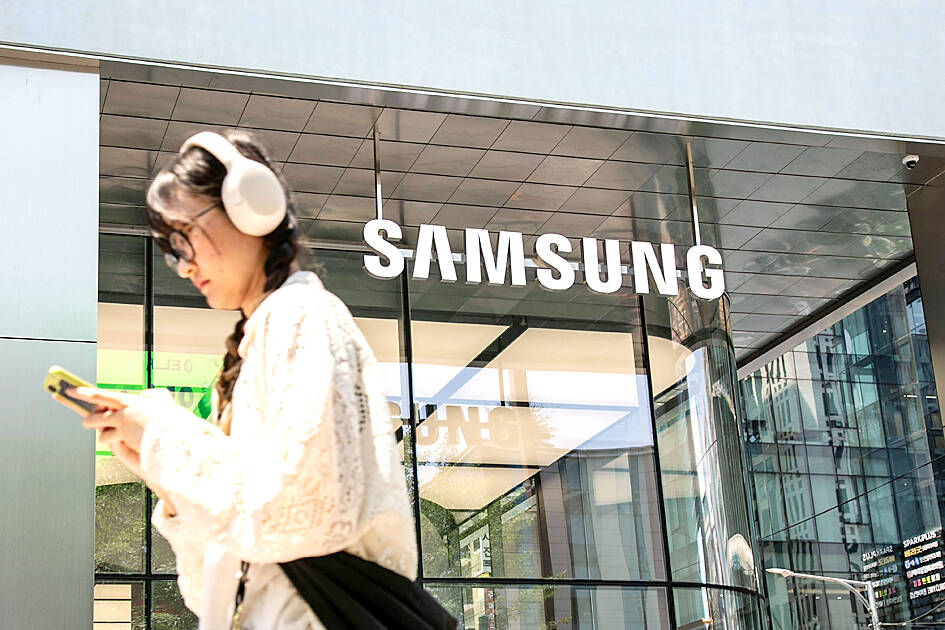Samsung Electronics Co is laying off workers in Southeast Asia, Australia and New Zealand as part of a plan to reduce its global headcount by thousands of jobs, sources familiar with the situation said.
The layoffs could affect about 10 percent of its workforces in those markets, although the numbers for each subsidiary might vary, said one of the sources, who asked not to be named because the matter is private.
Job cuts are planned for other overseas subsidiaries and could reach 10 percent in certain markets, the source said.

Photo: Bloomberg
The South Korean company has about 147,000 in staff overseas, more than half of its total employees of more than 267,800, its latest sustainability report said.
It is not planning layoffs in its home market.
Samsung staff across different teams in Singapore were called into private meetings on Tuesday with human resource managers and their reporting managers, and were informed of the retrenchment and severance package details, another source familiar with the matter said.
“Some overseas subsidiaries are conducting routine workforce adjustments to improve operational efficiency,” a Samsung spokesperson said.
“The company has not set a target number for any particular positions,” the spokesperson added.
Samsung shares have slid more than 20 percent this year as the world’s largest maker of memory chips and smartphones struggles in key markets. It has fallen behind rival SK Hynix Inc in the memory chips used for artificial intelligence (AI), and has made little progress against Taiwan Semiconductor Manufacturing Co (台積電) in the production of custom-made chips for outside customers.
The task of leading Samsung through its latest challenges now falls to executive chairman Jay Y. Lee, grandson of the company’s founder. The 56-year-old was acquitted of stock manipulation charges in February after years of legal troubles.
Samsung is in the unusual position of playing catch-up to SK Hynix, which took the lead in producing the high-bandwidth memory chips that are paired with Nvidia Corp’s AI accelerators to train AI models.
Samsung abruptly replaced the head of its chip business this year and the newly appointed chief, Jun Young-hyun, said the company had to change its workplace culture or get caught in a “vicious cycle.”
The company has reduced the size of its workforce in the past as it has navigated the notoriously cyclical memory-chip market. Samsung recently trimmed about 10 percent of jobs in India and some parts of Latin America, according to one of the sources.
In the latest push, Samsung is likely to cut less than 10 percent of its total overseas staff of 147,000, the source said.
The company aims to preserve manufacturing jobs, while it cuts management and support functions. The figures would be affected by local labor regulations and financial priorities.
Samsung has also been feuding with employees in South Korea. The largest of the tech giant’s several unions called the company’s first strike ever in May.

Taiwan Semiconductor Manufacturing Co (TSMC, 台積電) last week recorded an increase in the number of shareholders to the highest in almost eight months, despite its share price falling 3.38 percent from the previous week, Taiwan Stock Exchange data released on Saturday showed. As of Friday, TSMC had 1.88 million shareholders, the most since the week of April 25 and an increase of 31,870 from the previous week, the data showed. The number of shareholders jumped despite a drop of NT$50 (US$1.59), or 3.38 percent, in TSMC’s share price from a week earlier to NT$1,430, as investors took profits from their earlier gains

In a high-security Shenzhen laboratory, Chinese scientists have built what Washington has spent years trying to prevent: a prototype of a machine capable of producing the cutting-edge semiconductor chips that power artificial intelligence (AI), smartphones and weapons central to Western military dominance, Reuters has learned. Completed early this year and undergoing testing, the prototype fills nearly an entire factory floor. It was built by a team of former engineers from Dutch semiconductor giant ASML who reverse-engineered the company’s extreme ultraviolet lithography (EUV) machines, according to two people with knowledge of the project. EUV machines sit at the heart of a technological Cold

TAIWAN VALUE CHAIN: Foxtron is to fully own Luxgen following the transaction and it plans to launch a new electric model, the Foxtron Bria, in Taiwan next year Yulon Motor Co (裕隆汽車) yesterday said that its board of directors approved the disposal of its electric vehicle (EV) unit, Luxgen Motor Co (納智捷汽車), to Foxtron Vehicle Technologies Co (鴻華先進) for NT$787.6 million (US$24.98 million). Foxtron, a half-half joint venture between Yulon affiliate Hua-Chuang Automobile Information Technical Center Co (華創車電) and Hon Hai Precision Industry Co (鴻海精密), expects to wrap up the deal in the first quarter of next year. Foxtron would fully own Luxgen following the transaction, including five car distributing companies, outlets and all employees. The deal is subject to the approval of the Fair Trade Commission, Foxtron said. “Foxtron will be

INFLATION CONSIDERATION: The BOJ governor said that it would ‘keep making appropriate decisions’ and would adjust depending on the economy and prices The Bank of Japan (BOJ) yesterday raised its benchmark interest rate to the highest in 30 years and said more increases are in the pipeline if conditions allow, in a sign of growing conviction that it can attain the stable inflation target it has pursued for more than a decade. Bank of Japan Governor Kazuo Ueda’s policy board increased the rate by 0.2 percentage points to 0.75 percent, in a unanimous decision, the bank said in a statement. The central bank cited the rising likelihood of its economic outlook being realized. The rate change was expected by all 50 economists surveyed by Bloomberg. The